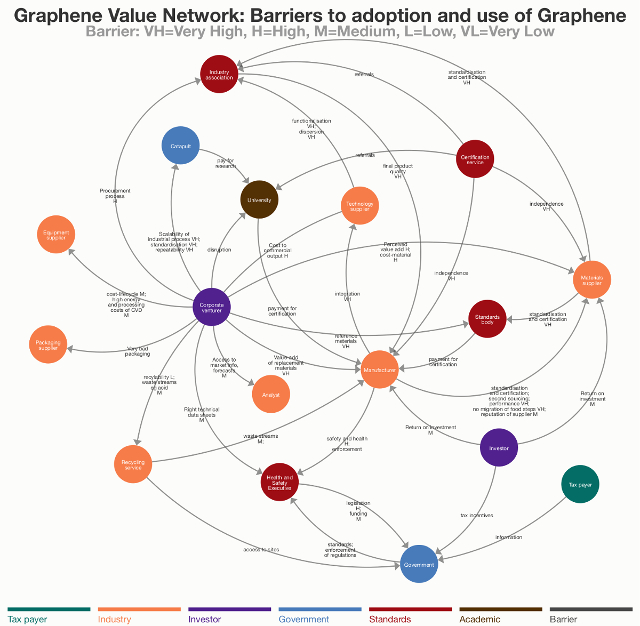Sep 7 2015
Everything we do – research, development, testing, manufacturing, investing, selling – is part of a value network.
Understanding what the value network looks like and how it may be changing can be very beneficial in terms of helping to protect or increase the value received or offered as changes occur. For example, Cambridge Investment Research (CIR) developed a value network map of the barriers to adoption and use of a new and otentially very enabling & high value functional material: graphene (see Figure).
The map shows 17 takeholder types from the areas of: industry, investor, government, standards bodies, academic institutions and the taxpayer (who ultimately funds public and some private research and development).

The map was developed during a one-day masterclass with participants from industry, professional services and academic backgrounds. The purpose of this value network analysis is to identify the barriers to the adoption and use of graphene by some of the different stakeholders in order to develop approaches to lowering or removing as many obstacles as possible.
Lowering or removing barriers should speed the growth of applications for graphene. These can be reduced by the provision of services, and hence service design has an important role in speeding up the growth of application. The map also shows flows between stakeholders with an arrow to indicate the flow direction. The flows can be money, product, information, or services, or combinations of one or more of these.
Needs and expectations
The arrows can also be indicators of the needs and expectations of a stakeholder. For example, one of the stakeholders – the materials supplier – expects the standards body to provide standardisation and certification.
Without such information, which is a service required by the materials supplier of the standards body, the materials supplier’s ability to supply may be limited and hence the growth of applications for graphene could be stunted.
On the CIR value network map of barriers to adoption and use of graphene, this is shown as a very high (VH) barrier to adoption based on the view of the experts in the group that contributed to the map’s development.
Development Preparation of the map is straightforward. A table of all stakeholders is created. The needs and expectations of each are discussed and agreed.
A description of the barrier and the direction of flow are noted. The impact of these needs and expectations in terms of barriers to adoption and use are then assessed on a simple scale from being a ‘very high’ barrier to very low’ barrier, and this is noted. The resulting updatable table is uploaded to a dynamic software suite on the Cloud. The software then generates the dynamic map with the data.
The map can be used to analyse and assess the role and importance of the stakeholders in terms of their connections to others.
Priorities
These data then help the understanding of priorities for action to be taken that will lower or remove the main barriers.
This understanding of priorities, underpinned by a rigorous analysis of the value network by expert participants in a group of organisations or a single company, can then be converted into a short summary of recommendations.
This can be for an executive, a management team, or the group of organisations.
An increasing number of leaders are coming to understand the use and importance of value network dynamics, and some now consider it to be sufficiently important and take responsibility for maintaining an up-to date, dynamic value network map both for the present and for the future on a senior management level.
If you would like to join a Leader's MasterClass - if you believe it falls to you in your organisation to drive forward strategy and monetisation of GRMs - then please do approach CIR for info or booking +44 1223 303500 (direct) for the MasterClass on 5 November 2015 in Cambridge as part of the Cambridge Graphene Technology Days 2015 festival of events including business conference, expo of tech, new lab tours and dinner.